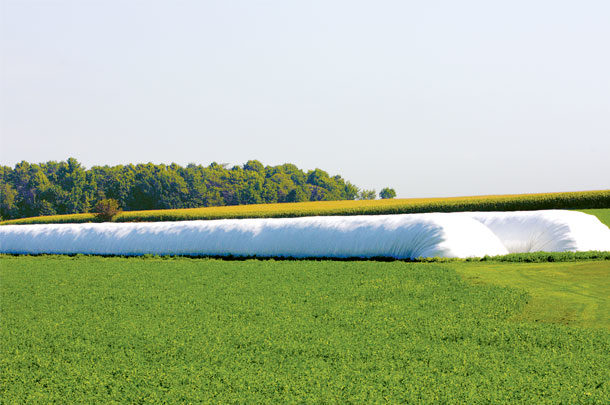More and more farmers are relying on bagged silage for good reason: Quality of their stored silage feed is improved by preserving it in these airtight storage units.
There are several advantages to bagging silage. First is feed quality. The silage-storage bags retain almost all the crop’s dry matter and nutritional elements. Typically, corn or hay crops are chopped and packed by a machine into the bags. The crop then goes through a fermentation process to preserve the feed and make it appealing for cattle consumption.
The fermentation process is critical to making quality silage. Once sealed in the bag, beneficial anaerobic fermentation begins to turn the fresh crop into silage. To aid the process, the silage bags are virtually airtight, preserving the palatability, appearance, smell and appeal of the feed. The less oxygen present, the better the conversion becomes, causing the feed to retain more of its energy and protein properties.
Bagging silage is very cost-effective. Bagged silage storage is a less expensive feed storage system than silos or bunkers. Instead of having a large investment in upright silos (which can cost from $100,000 to $150,000) or the investment in bunkers (which can cost as much as $250,000), the whole system of bagged feed storage costs roughly $5 to $6 per ton. Farmers who switched to bagging silage also found they eliminated silo or bunker maintenance costs and repair bills.
Then there’s the shrinkage and spoilage factor. Because silage stored in bags doesn’t have air affecting the product, if you bag 10,000 tons of silage, you’re going to get close to 10,000 tons out. If you stored that same amount of silage in a bunker, you’re only going to get about 8,000 tons, even though you put in 10,000 tons.
That’s a 20% loss. Bunker-style storage loss can cost $10,000 for every 1,000 tons of silage. By bagging silage, you’re going to have more feed, and you might be able to reduce the acreage required to feed your cattle. Or, if you do harvest the same amount of acreage, you’re going to have surplus to sell.
Another advantage is versatility. There are bagging systems available for the smallest to the largest dairy or livestock operation. And there is no limit to the types of feedstuffs that can be stored in a bag. Different crops can easily be kept in their own separate bags, and even different cuttings from one field can be stored in separate bags on the farm, providing the choice of feed type and quality to feed to various animals.
By storing silage in bags, you can easily segregate feed to make a better ration. You can test a new corn silage hybrid or keep your first, second and third hay crop cuttings separate and easily adjust rations for dry cows, heifers, etc.
Say, for example, you’re harvesting a 40-acre field. The top 20 acres may be great alfalfa hay, but the bottom 20 acres may be full of grass and weeds. You’ve still got to harvest that bottom 20 acres because it has forage in it. By bagging the haylage, you can take the better-quality product and segregate it so it’s going to your high-producing cattle while the lower-quality haylage is just going to feed heifers.
There’s no limit to the number of bags that can be filled or what you can put in them. That’s helpful in a year when you have a bumper crop and your permanent structures can’t hold additional crop. You can put pretty much anything in a bag – dry grain, wet grain, processed corn, dry distillers, wet distillers, orange peels, chopped straw or soybean stubble for bedding. What you put in a storage bag is pretty much up to you.
Bags could replace some grain storage facilities or silos. That’s actually how the bagging system originally came about. Farmers who were using their upright silos and needed more capacity for additional storage turned to bagging their crop. When they found the feed quality was better in a bag than in a silo, many farmers went to bagging all of their silage. And as far as capacity goes, even large-scale producers can get an adequate amount of storage by using a bagging system with silage-storage bags available in widths up to 14 feet.
You work hard to grow a high-quality feed, so it makes sense to store it in a system that prevents growth of aerobic bacteria and spoilage while it ferments and becomes an easily digestible and highly nutritious feed. Your cattle will thank you. ![]()
PHOTO: Bagged silage gains popularity as temporary forage storage among dairies and cattle ranches. Photo provided by Taylor W. Weisensel.
Taylor W. Weisensel is the sales and marketing manager with Ag-Bag.









